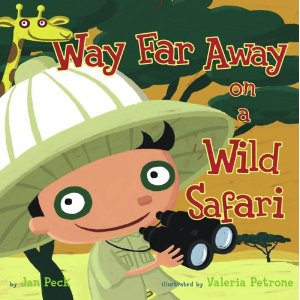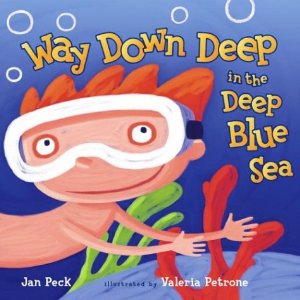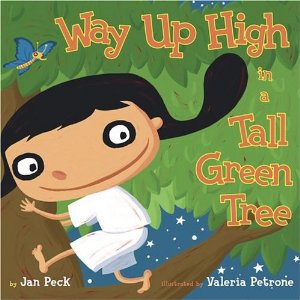Curriculum Guide:
Way Out Series
Award-winning Children’s Book Writer
Jan Peck
PRE-READING ACTIVITIES
Show pictures of different environments: Ocean, Rainforest and
African Savannah.
Ask students what kinds of animals live in each environment.
Have students draw pictures of the animals in each environment.
 DISCUSSION QUESTIONS
DISCUSSION QUESTIONS
♦ What are some of the differences in the animals?
♦ What are some of the similarities between the animals?
♦ What are some other environments that these books do not show?
Such as deserts or swamps.
♦ Where could these others be in your imagation. Desert could be a
sandbox. Swamp could be a mudpuddle.
Praise for Jan Peck’s Way Out series:
Books for the youngest scientists!
Simon & Schuster Books for Young Readers sells these books in USA, Australia, England, and Japan.
Way Up High in a Tall Green Tree is on the PBS Teacher Resource Recommended Science Book List.
Also see http://www.pbs.org/teachersource/prek2/theme/index.shtm.
PBS is the broadcast network of Sesame Street etc.
Featured in Time Magazine for Kids
Way Up High in a Tall Green Tree nominated for the Golden Spur Award for Texas Authors –
Children’s Literature division of Texas State Reading Association.
A finalist for The Institute of Texas Letters and Friends of the Austin Public Library Award for Best Children’s Book.
Way Down Deep in the Deep Blue Sea has been sold twice to another publisher in Korea.
Way Down Deep in the Deep Blue Sea is available in paperback and audio from Scholastic Book Clubs.
Included on Nick Jr.com: Blue’s Book Club List
Classroom Activities:
1. Creative Writing—Brainstorm a place that the class might “visit.”
When the class has decided on a destination, discuss the many things
that might be encountered along the way. List words and descriptors
for each thing. With predictability and rhyming, let each student
write and illustrate their own page to include in the class book.
2. Science—This book is excellent for introducing different creatures
to young children. The children can take turns acting like the
different animals. Read the book aloud and have a group of children
act out the action of each of the creatures as you get to that page.
Provide old nature magazines for the children to look through to find
additional examples of life. Post the pictures on the bulletin board to
make a classroom “aquarium”, “rainforest”, or “African savannah”.
3. Phonological Awareness—There are many rhyming words in this
book. In order to increase phonological awareness, as a class prepare
a Rhyming Ladder with all of the rhyming words in the story. To
start, pick one word from the text and write it onto a sentence strip.
Reread the story and have the children point out all of the rhyming
words that match that particular word. Write these words on sentence
strips and tape them to the original word in a ladder format.
Throughout the remainder of the month, if a student points out another
word that rhymes, add it to the Rhyming Ladder.
Web sites for more information:
http://www.everythingpreschool.com/themes/index.htm
http://homeschooling.gomilpitas.com/directory/Biology.htm
http://www.enchantedlearning.com/subjects/
Classroom Activities prepared by Karen Verhalen and edited by Jeanette Larson Reproducible


